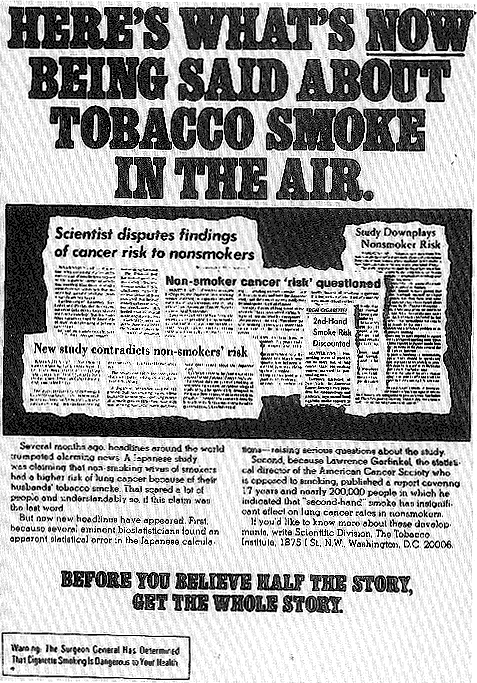Interesting Developments In The Hirayama Matter
Another technique that the tobacco industry has used to create a controversy surrounding the passive smoking issue is to attack published research on ETS. The documents show that, in at least one case, the industry has even criticized research that some of its own consultants acknowledged was valid.
In 1981 Takeshi Hirayama published a major study indicating that lung cancer could be caused by passive smoking as well as active smoking (3). The study, which was published in the British Medical Journal , received international attention. The tobacco industry responded by launching a public relations campaign to discredit Hirayama's work. The Tobacco Institute hired Nathan Mantel, a well-known epidemiologist, to critique the study, and it then cited Mantel's criticisms in a press release that was widely reported (34). The institute also reprinted several critical news articles as full-page advertisements in newspapers and magazines (35) (figure 10.1). Several months after the original publication of Hirayama's study, the British Medical Journal responded to the public attacks against Hirayama's work by reopening correspondence on his study. In particular, the editors stated that they were taking the "exceptional step" of publishing letters that had not been sent to BMJ , including

FIGURE 10.1. The Tobacco Institute ran this advertisement in newspapers and magazines all over
the United States shortly after publication, in 1981, of the first scientific paper linking
environmental tobacco smoke with lung cancer in nonsmokers.
Mantel's original report to the Tobacco Institute, to allow Hirayama to respond publicly to the criticisms of his work (33).
The documents show that, although the tobacco industry was publicly attacking Hirayama's paper, several of its own experts were privately admitting that his conclusions were valid. On July 24, 1981, J. K. Wells, B&W corporate counsel, wrote a memo to Ernest Pepples, B&W's vice president of law {1825.01}. The memo summarized a telephone conversation between Pepples and Tim Finnegan, an attorney with the firm of Jacob, Medinger, and Finnegan, regarding "Interesting Developments on the Hirayama Matter."
Dr. Adlkofer, who is the Scientific Director of the German Verband [the German equivalent of CTR, see chapter 2], has committed himself to the position that Lee [presumably Peter Lee, a British statistician and tobacco industry consultant] and Hirayama are correct and Mantel and TI [Tobacco Institute] are wrong. Adlkofer called Frank Colby at Reynolds [R. J. Reynolds Tobacco Co.] and said that Germany has received new data from Japan which confirms the Hirayama work. Adlkofer and Lee and another German associate were all asked to review Hirayama's work and did not find the error picked up by Kastenbaum [a statistician at the Tobacco Institute]. They believe Hirayama is a good scientist and that his nonsmoking wives publication was correct. Adlkofer invited Tsokos [affiliation unknown] and Kastenbaum to Germany to view the new data, although they would not be allowed to work with it or make copies. The proposal added that after the session in Germany Tsokos, Kastenbaum, and apparently Adlkofer would proceed to Japan to visit Hirayama. Adlkofer had previously proposed four research projects to examine the Hirayama work to be done by the research arm of the Verband. At a meeting of the board of the research arm of July 15 Adlkofer was asked how he could continue to support the projects if Hirayama's work was dead. He replied with a strong statement that Hirayama was correct, that the TI knew it and that TI published its statement about Hirayama knowing that the work was correct. Mr. von Specht [affiliation unknown] is reported to have cut Adlkofer short. Subsequently Adlkofer told Colby that unidentified authors would publish in an unnamed publication an article claiming that Hirayama was correct and that TI published its statement while privately acknowledging Hirayama's correctness. Within a few days Adlkofer called again to say that the article was off.
...
No comment is needed on the proposal to have Kastenbaum and Tsokos visit Germany to review the Hirayama data unless you believe the visit should take place. [Horace] Kornegay [of the Tobacco Institute] gave a forceful veto of the program and as of this point there is no dissent [emphasis added]. {1825.01}
The threatened letter from Adlkofer never materialized, and the industry and its consultants have maintained a unified public position that
Hirayama's study was flawed and that the health dangers of passive smoking have not been proven. Since then, Philip Morris and R. J. Reynolds have both run a series of full-page advertisements criticizing the U.S. Environmental Protection Agency's risk assessment of environmental tobacco smoke (2) (see figures 5.2 and 5.3). The Tobacco Institute has also continued to criticize Hirayama's paper and its use by regulatory bodies such as the Environmental Protection Agency and the Occupational Health and Safety Administration (35, 36). The scientific community, however, widely regards Hirayama's work as a landmark study on the health effects of ETS, and his findings have been confirmed by several other studies showing a link between passive smoking and lung cancer (37).
This episode indicates that the tobacco industry is not committed to learning and disseminating the truth about the health effects of its products. Rather, it has consistently attempted to discredit research even when its own scientists have admitted that the research results are valid. Just as the industry has continued to deny that active smoking has been proven dangerous to health, it continues to deny that the case is proven against passive smoking.